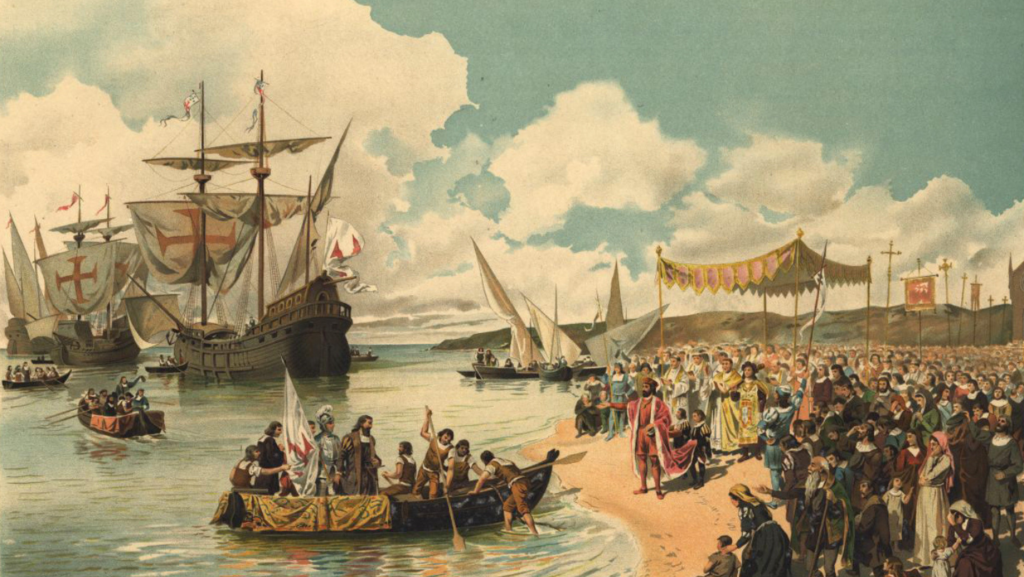by Emily Glankler
Here we go. In my view, the true AP World History course begins with Unit 4. By that I mean that this is the first time we see some semblance of a traditional, chronological narrative of world history. Let’s review of of the key AP World History Unit 4 Challenges.
Why is Unit 4 called “Transoceanic Interconnections?”

If Unit 3 was somewhat of a “repeat” of the Unit 1 approach, then Unit 4 is the Early Modern version of “Networks of Exchange.” Our main focus for Unit 4, of course, is the “discovery” of the Americas and their incorporation into Afro-Eurasian networks. While it can be tempting to focus all of our attention on the Atlantic Ocean and colonization of the Americas, remember that this course is way more concerned with how these developments impacted the entire world. For example, the establishment of Portuguese trading posts in the Indian Ocean is just as important as the Columbian Exchange. And the responses (or lack thereof) by major land-based empires in Asia to the arrival of “the West” is arguably the most critical for setting the stage for future clashes between new western maritime empires and traditional African and Asian states.
How should we approach the content of Unit 4?

Unit 4 can fairly easily be split in half: the first few topics are concerned with the Age of Exploration and early colonization. These sections can be covered quickly without needing too much detail (please, don’t force your kids to memorize all the explorers. I find that just knowing Columbus and Vasco da Gama does the trick.) The first half of Unit 4 is probably the first time in our course when students might already have some familiarity. Because of this, when you’re covering 4.1 to 4.4 is a great opportunity to do a deep dive into writing skills. I find that the Columbian Exchange is a great topic to really walk kids through an LEQ or a DBQ for the first time because the content itself is fairly simple (albeit tragic) and so we can cover content while also focusing on complex skills like essay writing, analysis and reasoning.
The far more important part of Unit 4 is the second half. While the first few topics focus mostly on Europe and its interactions with the Americas, 4.5 to 4.8 is the real “meat” of the unit. How did this new “discovery” change traditional state building practices? How did it shift the balance of power toward western Europe for the first time in our course? And, I think, most importantly: How did indigenous people around the world respond to the arrival of Europeans in their lands?
What details do students need to know from Unit 4?

Unit 4 is a unit that I would pay close attention to the CED provided by the College Board. Remember that any information within the Learning Objectives and Historical Developments (in the blue boxes) is content your students must know. Then, off to the side, they will often list out for you Illustrative Examples – think of this as a menu of options. In 4.4, for example, they list out four groups of Indian Ocean Asian merchants (Swahili Arabs, Omanis, Gujaratis, and Javanese.) Let’s be clear: your students do not need to know all four of these groups. They should just be able to at least discuss one as an illustrative example of the Indian Ocean trade continuing to flourish thanks to Asian merchants.
One of the most important topics in the entire course, in my opinion, is 4.6 “Internal and External Challenges to State Power from 1450 to 1750.” It’s an important topic to help dispel the idea that Europeans dominated other regions as soon as they arrived on the scene. The section on “local resistance” is especially salient for those of us (I hope all of us) looking to diversify our curriculum and make sure that students of color learn their own history beyond just conquest and subjugation. I spend a few days allowing my students to choose one indigenous resistance leader to research as part of a Movie Project (they create materials for that leader’s eventual biopic, inspired by the 2019 film Harriet.)
In general, just be careful of approaching this unit too Euro-centrically. AP European History can explore the intricacies of the Protestant Reformation and Catholic response; or the various competing explorers of Spain and Portugal. For our purposes, we would be better off spending our time on the impact of “Discovery” on the people of the Americas and Africa and the slowly shifting balance of power in the Asian world.
I still don’t quite understand “Transoceanic Connections.” What other resources are out there to help me get through Unit 4?
Here are some of my other favorite tried-and-true resources for Unit 4.
YouTube Reviews
- “AP World History Unit 4: Transoceanic Interconnections” (Anti-Social Studies)
- “AP World History Unit 4 Playlist” (Heimler’s History)
- “AP World History Modern: Unit 4 Review” (Stephanie Gorges)
- “4.2 Deep Dive: Prince Henry the Navigator” (Anti-Social Studies)
- “Illustrative Examples: Dutch fluyt” (Freeman-pedia)
- “Illustrative Examples: Cossacks” (Freeman-pedia)
- “Illustrative Examples: Moroccan-Songhai Conflict” (Freeman-pedia)
Unit 4 Lesson Plans and Resources
- Unit 3 LEQ Workshop / “Build Your Own Ear”Indigenous Resistance Movie Project” lesson available in the AP World Teacher Starter Pack (Anti-Social Studies)
- Unit 4: Transoceanic Interconnections (Freeman-pedia)

Emily Glankler has taught almost every Social Studies course for the past decade from 6th grade World Cultures through AP® U.S. History but her favorite course to teach is AP® World History. She has taught AP® History courses at both private and public high schools in Austin, Texas and she was the team lead responsible for bringing AP® World (and building the curriculum from scratch) to the last two high schools where she has taught. Emily has also led professional development within Austin ISD as an Instructional Coach as well as presenting to an audience at SXSW EDU about incorporating current events into the core curriculum. She has a B.A. in History from the University of North Carolina at Chapel Hill and an M.A. in History from Texas State University. In addition to teaching full time, Emily also writes and produces a history podcast called Anti-Social Studies that is used by teachers and students in history classrooms around the country.
 Help
Help